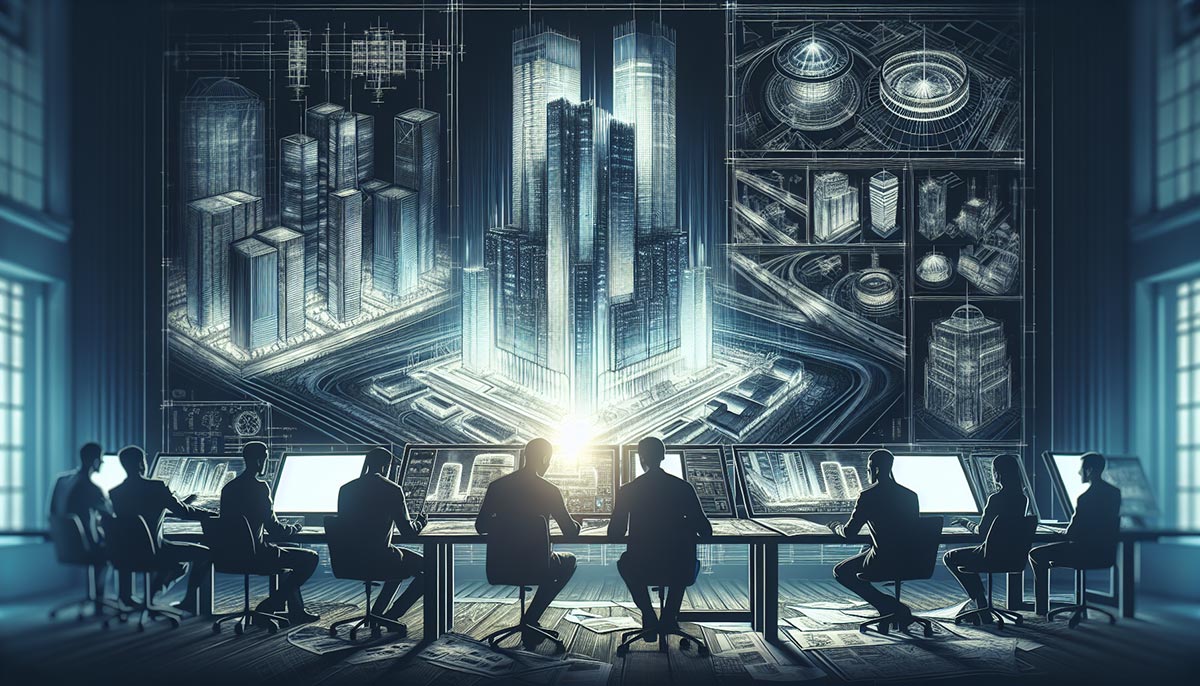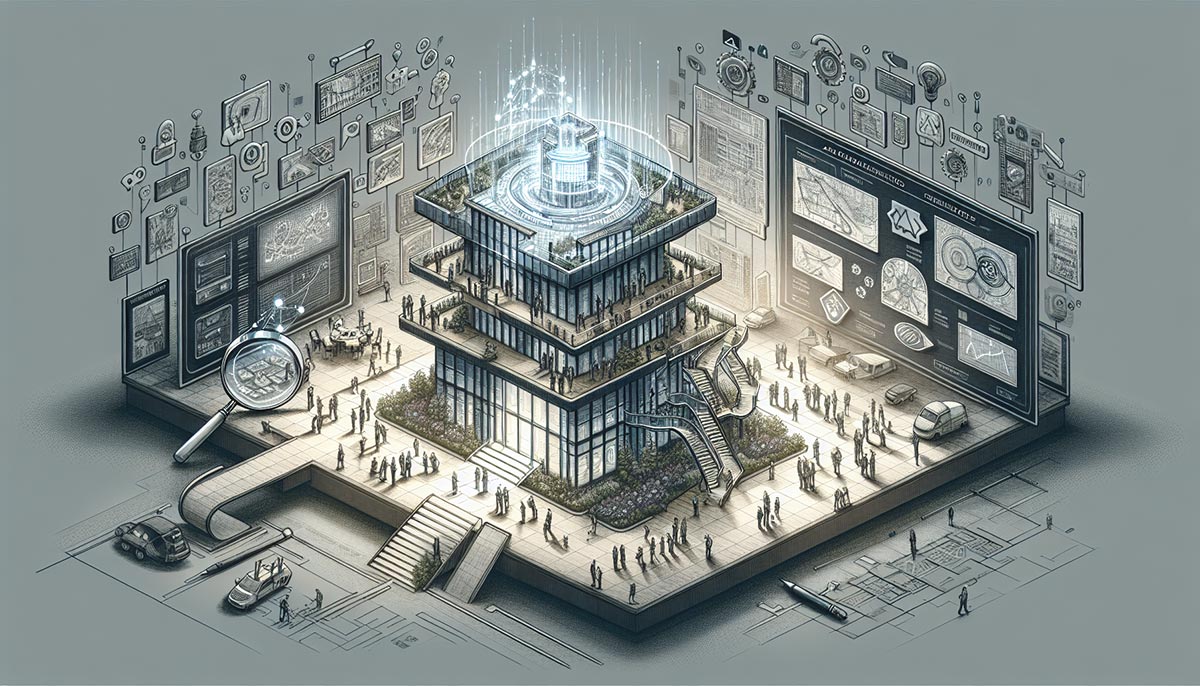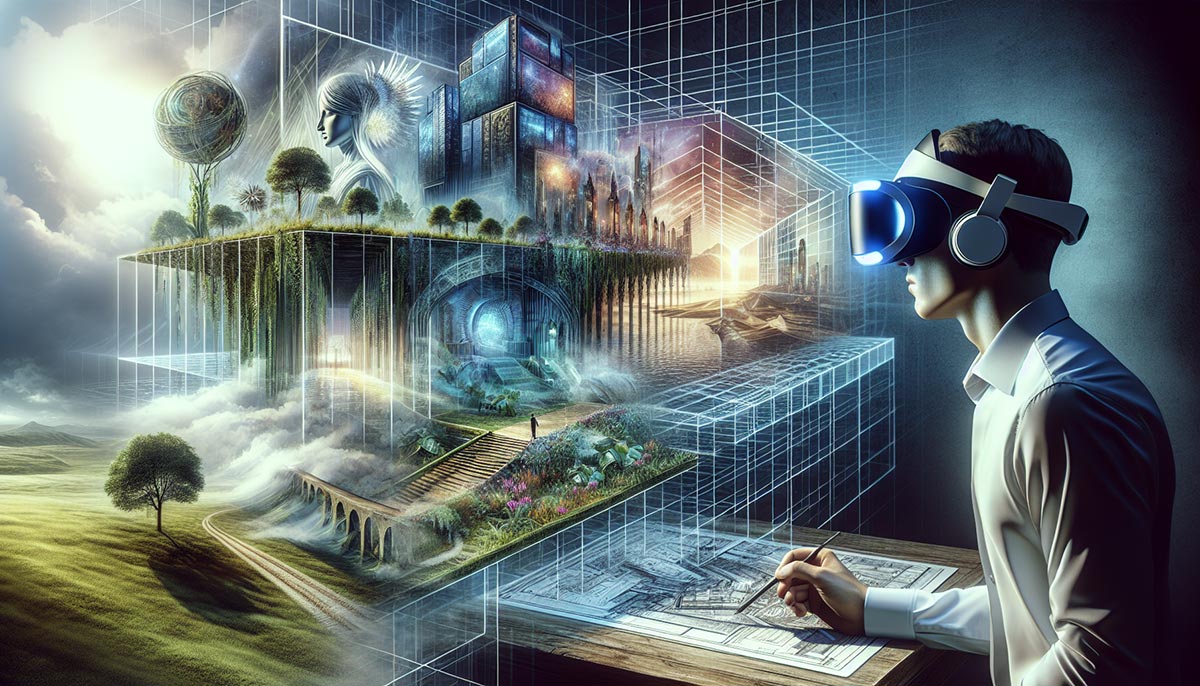The Essentials of Architect Rendering: Boosting Your Design Process

3D agora
July 29th, 2024

Architect rendering translates architectural plans into realistic images, helping visualize designs before they’re built. This guide covers the types, benefits, and techniques of architect rendering to show how it enhances design clarity and communication.
Understanding Architect Rendering
 Generated by SurferAI
Generated by SurferAI
At the heart of every construction blueprint and design concept lies a vision waiting to be realized. Architectural rendering is the bridge that connects the abstract to the tangible, transforming proposed architectural designs into photorealistic images that breathe life into mere sketches. Whether it’s a cozy interior rendering, a majestic exterior, or a comprehensive aerial view, architectural renders transform architects’ ideas into 3D visual narratives.
These digitally rendered environments offer a complete view of design concepts, allowing stakeholders to grasp the value and justify the intricacies of an architectural project with unprecedented clarity. Thanks to rendering software and techniques, architects can present their visions with such detail and accuracy that it’s akin to peering through a window into the future.
Types of Architectural Renderings
 Generated by SurferAI
Generated by SurferAI
As we delve further into architectural visualization, we come across various rendering types, all presenting unique perspectives to view proposed architectural designs. These include:
Interior renderings: These focus on the intimate details of the interior spaces, showcasing materials, lighting, and furniture arrangements.
Exterior renderings: These provide a visual representation of the building’s exterior, highlighting its architectural features, landscaping, and surrounding environment.
Aerial renderings: These offer a bird’s-eye perspective of the design, giving a comprehensive view of the building and its surroundings.
Each rendering type serves a specific purpose and helps enhance understanding and communication of the design across various platforms.
We should examine how each rendering type encapsulates distinctive aspects of architectural projects.
Interior Renderings
Interior renderings, representing the essence of a space, capture the interplay of light and shadow across materials, the balance between fixtures and furnishings, and the ambience that transforms a building into a home. They are the canvas on which interior designers paint their vision, allowing clients to visualize not just a room, but the stories that will unfold within its walls.
From the reflective gleam of a marble countertop to the soft caress of daylight across a wooden floor, interior renderings give life to design ideas, enabling an immersive experience that evokes emotion and connection.
Exterior Renderings
In contrast, exterior renderings represent the facade of architectural intent, demonstrating a structure’s imposing presence within its environment. They are a testament to an architect’s foresight, illustrating:
how materials will age under the caress of the elements
how light will play across facades
how the building will stand as a testament to design ingenuity.
Whether it’s capturing the reflection of the setting sun on glass panels or the integration of green spaces in urban design, exterior rendering conveys the proposed architectural design’s impact on the skyline and the community it will serve.
Aerial Renderings
Aerial renderings provide a viewpoint that situates the project within its broader context, unfolding the connection between the proposed design and the surrounding landscape. From this vantage point, one can appreciate the scale of a development, the flow of traffic patterns, and the interplay between nature and the built environment. These renderings are particularly invaluable in urban planning and landscape design, providing a comprehensive overview that no ground-level view could match, thereby enhancing the stakeholders’ understanding of the project’s scope and integration.
The Process of Creating Architectural Renderings
 Generated by SurferAI
Generated by SurferAI
The creation of architectural renderings is a meticulous process that blends art with technology, requiring a keen eye for detail and a profound understanding of architectural principles. From initial sketches to the final polished image, every step is a deliberate act of creation, employing a variety of tools and techniques to bring a proposed architectural design from concept to captivating visual story.
We should traverse the stages that convert a basic model into a vibrant, photorealistic image.
3D Modeling Software
The cornerstone of any architectural rendering is the 3D modeling software. It is within these programs that ideas take shape, where every element of a proposed architectural design is meticulously sculpted, textured, and refined. The choice of software can make or break a rendering, influencing not only the visual quality but also the efficiency of the design process.
Some popular three dimensional modeling software used by architects include:
Autodesk Revit
SketchUp
Rhino
3ds Max
ArchiCAD
Each computer software has its own strengths and weaknesses, so it’s important to choose the one that best suits your needs and preferences.
Modern rendering software integrates seamlessly with BIM or CAD programs, streamlining workflows and enhancing project decision-making, while also allowing for on-the-fly adjustments that save time and resources.
Adding Textures and Lighting
Once the 3D model is crafted, the next step is to breathe life into it with textures and lighting – the elements that transform a flat, monochromatic model into a vibrant, realistic rendering. Textures replicate the tactile qualities of surfaces, from the roughness of stone to the smoothness of glass, while lighting sets the mood and atmosphere, casting shadows and highlights that define form and space.
Gaining proficiency in these elements is vital, as they significantly influence the virtual perception and experience of the architectural design.
Final Touches and Post-Processing
The final stage of creating an architectural rendering is post-processing, where the raw image produced by the rendering software is refined to perfection. This phase involves adjusting colors, correcting imperfections, and adding special effects to enhance the visual appeal of the rendering. It’s a phase where artistry comes to the fore, allowing the renderer to infuse the image with a unique ambiance and a signature touch that elevates it from a mere representation to a piece of art that captivates and compels.
Benefits of Architectural Renderings
 Generated by SurferAI
Generated by SurferAI
Architectural renderings offer advantages that surpass their visual attractiveness. They serve as powerful tools in the design process, assisting in everything from communicating design intent to enhancing marketing materials and facilitating rigorous design analysis. Renderings allow the envisioned design to be explored, refined, and presented in a way that is both accessible and engaging to all project stakeholders.
Whether for residential, commercial, or public spaces, these realistic renderings are invaluable assets that drive informed decision-making and project success.
Communicating Design Intent
Architectural renderings possess the unique ability to communicate complex design ideas with clarity and precision. Through photorealistic images and virtual tours, they bridge the gap between architects’ visions and clients’ understanding, fostering a dialogue that leads to better-informed decisions and more effective collaboration.
Renderings serve as a visual language that can express the nuances of design intent, including:
the overarching concept
the spatial layout
the materiality and finishes
the lighting and ambiance
the landscaping and site context
the furniture and fixtures
By using renderings and architectural illustration, architects can ensure that every aspect of the proposed architectural design is conveyed and understood during the design development process.
Enhancing Marketing Materials
In the competitive landscape of real estate and architecture, renderings are invaluable marketing assets. They provide a glimpse into the future, allowing real estate agents, developers, and marketers to showcase properties and projects in their best light before they are even built.
Architectural renderings can be used across various media platforms, from social media to print brochures, elevators, and marketing campaigns that generate buzz and captivate potential buyers.
Facilitating Design Analysis
One of the most pragmatic benefits of architectural renderings is their role in design analysis. By offering a detailed visualization of the proposed project, renderings enable architects and clients to examine and iterate on design elements efficiently. This early detection of potential issues can lead to cost savings and a smoother construction process, as changes can be made digitally before ground is broken.
Renderings also allow for a comprehensive review of how a design utilizes space, which is critical for achieving an optimal layout and avoiding unforeseen challenges.
Advanced Rendering Techniques
 Generated by SurferAI
Generated by SurferAI
As technology evolves, so do the techniques used in architectural rendering, ushering in an era of advanced visualization methods that provide deeper immersion and interactivity. From virtual reality experiences that transport users into a digitally rendered environment to interactive walkthroughs that offer a self-guided tour of a space, these cutting-edge techniques are changing the face of architectural visualization.
We should investigate how these novel techniques are improving our interaction with and comprehension of architectural designs.
Virtual Reality (VR) Renderings
Virtual reality renderings are at the forefront of this technological revolution, offering a level of immersion that traditional renderings cannot match. By donning a VR headset, clients and stakeholders can step into a fully realized digital world, exploring every corner of a proposed architectural design as if it were already built. This sense of presence not only elevates the client experience but also provides a powerful tool for making informed decisions about the design and function of a space.
Interactive Walkthroughs
Interactive walkthroughs take the concept of visualization a step further by allowing clients to:
Navigate through a digital model at their own pace
Explore different design options
Understand spatial relationships
Identify potential issues that may not be immediately apparent in static renderings
These virtual tours enable users to have a more immersive and interactive experience.
By offering a more hands-on approach to architectural visualization, interactive walkthroughs empower clients to engage with the design on a more personal level.
Photomontage
Photomontage is an artful technique that seamlessly combines elements of photography with 3D rendering, resulting in composite images that are both stunning and informative. By integrating a proposed architectural design into an existing photograph of a site, photomontages provide a realistic depiction of how a project will look within its actual surroundings.
This merging of real and virtual elements is particularly effective for visual impact assessments and for helping stakeholders envision the future integration of a project within its environment.
Choosing the Right Rendering Service
Due to the intricacy and significance of architectural renderings, choosing an appropriate service provider is a pivotal decision. Clients must consider factors such as:
Technical expertise
Cost
Turnaround time
Quality of past work
to ensure they partner with a rendering service that aligns with their project’s goals. By carefully evaluating these aspects, clients can choose a collaborator who will not only deliver stunning visuals but also contribute to the overall success of the project.
Evaluating Expertise
In the evaluation of a rendering service, the necessary expertise takes precedence. A provider’s ability to produce intricate details and authentic lighting can make a substantial difference in the realism of the final render. It’s crucial to select a company with a proven track record of delivering high-quality, detailed architectural visualizations that effectively communicate the essence of a design.
This level of expertise ensures that the final renderings will meet and exceed client expectations, facilitating informed decision-making throughout the project lifecycle.
Considering Cost and Time
Budget and timeline invariably hold precedence in any project decision-making process. When it comes to rendering services, understanding the cost implications and the time required for project completion is essential. Pricing structures vary, and clients should seek a service that offers transparency and flexibility to accommodate their specific needs.
Additionally, clients should align with a provider that can deliver within their schedule, especially when renderings are needed to meet critical milestones or marketing launches.
Reviewing Portfolios
The portfolio of a rendering service serves as a glimpse into their previous projects and signifies their ability to create work in line with a client’s vision. Reviewing portfolios not only showcases a provider’s creative range and technical proficiency but also provides insights into their ability to handle projects similar to the client’s.
A strong portfolio with a variety of high-quality renderings is a testament to a company’s experience and skill, and is a crucial factor in the selection process.
Summary
Architectural renderings are not merely images; they are a vital component of the architectural process that brings ideas to life, enhances communication, and drives project success. From the delicate interplay of light and texture in interior renderings to the grandeur of aerial perspectives, rendering is an indispensable tool for architects and clients alike. As we embrace advanced techniques and select the right rendering services, we empower ourselves to envision, refine, and realize architectural designs that inspire and endure.